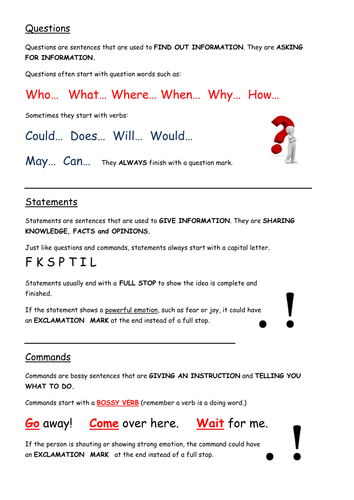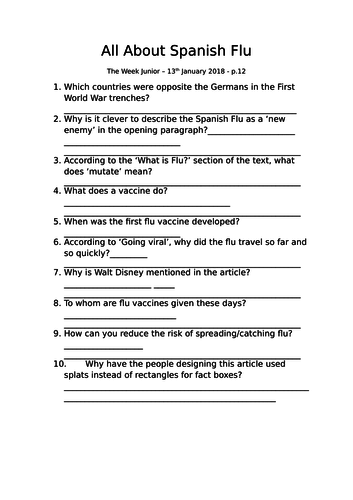46Uploads
41k+Views
16k+Downloads
English language arts

Sentence types: Statements, Commands, Questions and Exclamations
This double-sided sheet introduces these four sentence types, explaining what they are are what punctuation they need. It looks at statements, commands and questions first before checking understanding with a simple quick identification exercise. It then looks at exclamations (as these are a little harder to explain) and gives another 5 sentences for children to identify whether they are statements or exclamations.

Simile matching and writing activity
This resource allows for work on eight sentences of similes, using 'like', 'as' and 'as if'.
It is a cut, match and stick activity.
The first five sentences require the children to match the starts and ends of sentences, with pictures to try and help them see the connections.
The last three sentences have the starts of the sentences and blank boxes for them to create their own endings, with enough room to draw a picture to help show the comparison.
Images have been labelled as appropriate for reuse via the advanced search of Google images.

Reading Comprehension - The Week Junior - 13.01.18 - Spanish Flu
If your children read The Week Junior, get them to read the ‘All about Spanish Flu’ article on p.12 in the 13th January 2018 edition. Follow it up with this quiz which is based mainly on reading comprehension skills. 10 questions. Great for morning work or guided reading.

Reading Comprehension - The Week Junior - 13.01.18 - Trump
If your children read The Week Junior, get them to read the President Trump article on p.2 in the 13th January 2018 edition. Follow it up with this quiz which is based on reading comprehension skills. 10 questions. Great for morning work or guided reading.

Homophones (4 activities with increasing difficulty)
Teaching homophones for an entire lesson is pretty hard work and the children get so overloaded with words that they can’t remember them all. So I created four smaller 10-20 minute activities to use as lesson starters or fillers to give children the words in smaller doses.
The first is a powerpoint, which would work best as a whole class with whiteboards. It asks if children know any different spellings for a given word and then uses pictures to support the teacher in giving definitions of the words.
The second is a matching activity (matching homophones to their definitions) that pupils could complete in pairs. These words are trickier and may require the children to use dictionaries.
The third activity is a gap fill, asking the children to choose the right homophone to complete the sentence. Again, dictionaries could be useful.
The final activity asks pupils to write their own sentences to show that they understand the different meanings of homophones. There is a points element that could help make this competitive if that’s the way you class works!
All activities meet NEW homophones; they are not repeated from previous activities.

The Midnight Gang - questions, discussions and activities by chapter
As I read through The Midnight Gang by David Walliams, I jotted down ideas of questions and activities to do with my pupils. Organised by chapter, this powerpoint has over 50 slides with questions that cover all aspects of reading comprehension. Some have short, instant answers and others could be expanded into a 20 minute class discussion. For the creative teacher, there are many ideas and questions that could easily be developed into something exciting and memorable for the children. Some activities have been indicated as potentially cross-curricular, including opportunities for art, geography, science, drama and debate.
My purpose in adding this to TES is to provide teachers with a resource they could use in class with little or no preparation. Other teachers may not want to use it directly with the children but use it as a planning aid for their own lessons.

Choosing between ar and er/ir/ur sounds
Some basic pictures with words underneath so that children can fill in the correct vowel sound. I had taught ‘ar’ in a recent lesson and er/ir/ur in this lesson, so I wanted something that would practise current learning but also revise previous learning.

The Highwayman Unit - 5 sessions
This document has ideas for splitting The Highwayman into five sections with a follow up activity for each. These include a character sketch, a news report, a diary entry etc. An example of each of the follow up activities is given, written by one of my students, which you could share as model for your students. There is a basic outline of ideas on the document but you may wish to make your own powerpoints/extra resources.








